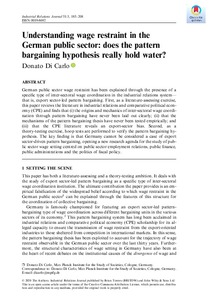Understanding wage restraint in the German public sector: does the pattern bargaining hypothesis really hold water?

2020
51
3
May
185-208
wage restraint ; public sector ; labour relations
Wages and wage payment systems
https://doi.org/10.1111/irj.12288
English
Bibliogr.;Charts
"German public sector wage restraint has been explained through the presence of a specific type of inter‐sectoral wage coordination in the industrial relations system—that is, export sector‐led pattern bargaining. First, as a literature‐assessing exercise, this paper reviews the literature in industrial relations and comparative political economy (CPE) and finds that (i) the origins and mechanics of inter‐sectoral wage coordination through pattern bargaining have never been laid out clearly; (ii) that the mechanisms of the pattern bargaining thesis have never been tested empirically; and (iii) that the CPE literature reveals an export‐sector bias. Second, as a theory‐testing exercise, hoop tests are performed to verify the pattern bargaining hypothesis. The key finding is that Germany cannot be considered a case of export sector‐driven pattern bargaining, opening a new research agenda for the study of public sector wage setting centred on public sector employment relations, public finance, public administrations and the politics of fiscal policy."
Digital
The ETUI is co-funded by the European Union. Views and opinions expressed are however those of the author(s) only and do not necessarily reflect those of the European Union or the ETUI.